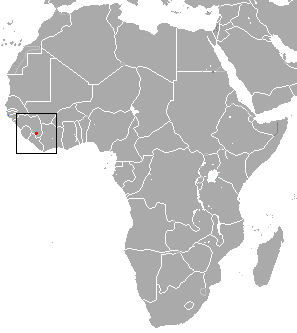Ziama horseshoe bat facts for kids
Quick facts for kids Rhinolophus ziama |
|
|---|---|
| Conservation status | |
| Scientific classification | |
| Genus: |
Rhinolophus
|
| Species: |
ziama
|
 |
|
| Range | |
The Ziama horseshoe bat (Rhinolophus ziama) is a type of bat. It belongs to a group of bats called the Rhinolophidae family. Scientists first officially named and described this bat in 2002.
You can find the Ziama horseshoe bat in West African countries like Guinea, Sierra Leone, and Liberia. It lives in warm, wet forests, both in low areas and on mountains. In 2013, a group called Bat Conservation International listed this bat as one of 35 top priority species to protect around the world.
What Does the Ziama Horseshoe Bat Look Like?
The Ziama horseshoe bat is smaller than another bat called the Maclaud's horseshoe bat. This size difference helps scientists tell them apart. Even though it's smaller than Maclaud's, it's still one of the biggest horseshoe bats found in Africa.
Adult Ziama horseshoe bats weigh about 20 to 24 grams (0.7 to 0.8 ounces). Their forearms are about 58 to 60 millimeters (2.3 to 2.4 inches) long. Their ears are long, about 35 to 37 millimeters (1.4 to 1.5 inches), and have pointy tips. Inside their ears, they have 11 to 12 folds.
Their noseleafs are about 11.5 millimeters (0.45 inches) wide and almost cover their snouts. The bat's fur, called its pelage, is soft and feels like wool. The fur on its back (dorsal side) is lighter at the bottom and darker at the tip. The fur on its belly (ventral side) is a uniform buffy color.
The R. maclaudi Bat Group
The group of bats called Rhinolophus has many different species. To help organize them, scientists split them into smaller groups. The Maclaud's horseshoe bat is the leader of one of these groups, called the maclaudi group. This group currently has six species. Three of these species were only discovered after 2003.
Bats in the maclaudi group have large ears. Also, a part of their nose, called the sella, is not strongly connected to another part, called the lancet.
Here are the six species in the maclaudi group:
- Maclaud's horseshoe bat (R. maclaudi)
- Rhinolophus willardi (discovered in 2013)
- Ruwenzori horseshoe bat (R. ruwenzorii)
- Hill's horseshoe bat (R. hilli)
- Rhinolophus kahuzi (discovered in 2013)
- Ziama horseshoe bat (R. ziama)
The Maclaud's horseshoe bat and the Ziama horseshoe bat are found in West Africa. The other four species live further east, near a place called the Albertine Rift. The West African species are generally larger than the East African ones. The Maclaud's horseshoe bat is the biggest bat in this entire group.
These species look very similar. Because of this, scientists used to think that R. hilli and R. ruwenzorii were the same kind of bat. They even thought they might be a type of subspecies of the Maclaud's horseshoe bat.
Protecting the Ziama Horseshoe Bat
As of 2002, scientists had only found four Ziama horseshoe bats. They caught all of them using special nets, called mist-nets, in 1990 and 1992. Three of these bats were found in the Ziama Massif in Guinea. The fourth one was caught in the Wonegizi Nature Conservation Unit in Liberia.
Based on these two locations, people worried that the bat's home range was very small, possibly only about 32 square kilometers (12 square miles). There were also concerns that the Second Liberian Civil War might have harmed its habitat in Liberia.
In 2006, a fifth Ziama horseshoe bat was found in Sierra Leone. This discovery showed that the bat's range was much larger than thought, extending about 450 kilometers (280 miles) further.
The Ziama horseshoe bat is one of five types of microbats in Africa that are listed as endangered by the IUCN. This means they are at a high risk of disappearing forever if we don't protect them.


